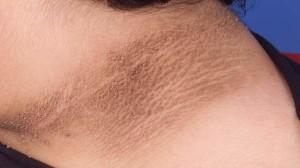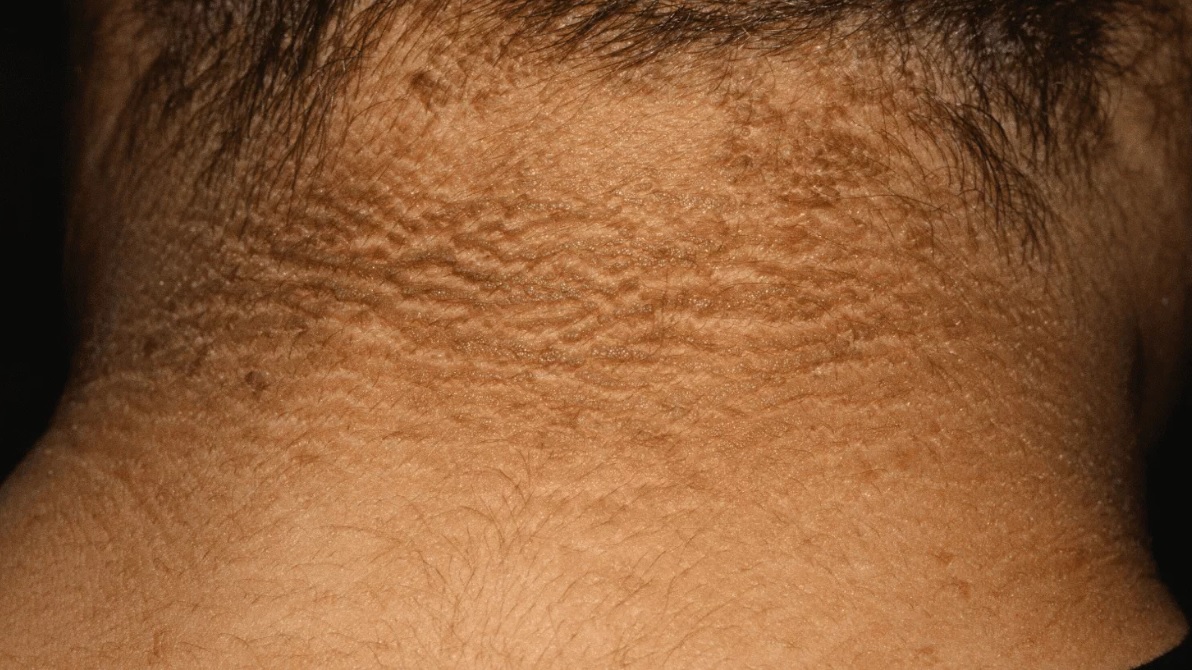What's in this article?
What is Acanthosis Nigricans?
Acanthosis nigricans is a brown to black, poorly defined, velvety hyperpigmentation of the skin. It is usually found in body folds, such as the posterior and lateral folds of the neck, the armpits, groin, navel, forehead, and other areas.
Acanthosis nigricans is a fairly common skin pigmentation disorder. The most notable sign of acanthosis nigricans is dark patches of skin with a thick, velvety texture. These patches may appear on the armpits, groin, neck, elbows, knees, knuckles, or skin folds. Lips, palms, and soles of the feet may also be affected.
Acanthosis nigricans may be a sign of a more serious health problem such as pre-diabetes. The most effective treatments focus on finding and resolving medical condition at the root of the problem. Fortunately, these skin patches tend to disappear after successfully treating the root condition.
What Causes Acanthosis Nigricans?
Acanthosis nigricans can affect otherwise healthy people, or it can be associated with certain medical conditions. Sometimes acanthosis nigricans is congenital (something a person is born with). It also can occur as a result of obesity or an endocrine (glandular) disorder. It is frequently found in people with diabetes or a tendency towards diabetes and is most common among people of African descent. There are many other possible causes of acanthosis nigricans, including:
- Addison’s disease, a condition caused by a deficiency of hormones from the adrenal gland
- Disorders of the pituitary gland within the brain
- Growth hormone therapy
- Hypothyroidism (low levels of thyroid hormone caused by decreased activity of the thyroid gland)
- Oral contraceptives
Most people with acanthosis nigricans have an insulin level that is higher than that of people of the same weight who don’t have acanthosis nigricans. Eating too much of the wrong foods, especially starches and sugars, can raise insulin levels.
Rarely, people with certain types of cancer can also develop acanthosis nigricans.
Symptoms of Acanthosis Nigricans
Skin changes are the only signs of acanthosis nigricans. You’ll notice dark, thickened, velvety skin in body folds and creases typically in your armpits, groin and neck. The skin changes appear slowly, sometimes over months or years. The affected skin may also smell bad or itch.

Acanthosis Nigricans Treatment
Eating a special diet can help reduce circulating insulin and may lead to some improvement of the acanthosis nigricans.
Other treatments to improve skin appearance include Retin-A, 20% urea, alpha hydroxyacids, topical vitamin D, and salicylic acid prescriptions. These are only minimally effective, however.
Acanthosis nigricans caused by a drug may go away once the medication is stopped.
Can Acanthosis Nigricans be Prevented?
When acanthosis nigricans is related to obesity, weight management is an important part of prevention. A diet that contributes to reduced insulin also can help prevent acanthosis nigricans.
Other preventive strategies include treating medical problems that are linked to acanthosis nigricans (such as hypothyroidism) and avoiding medications that tend to cause or worsen the condition (like birth control pills).
Who Is at Risk for Acanthosis Nigricans?
Acanthosis nigricans is seen in both men and women. It is most common in those who are overweight, have darker skin, and have diabetes or pre-diabetic conditions.
The frequency of acanthosis nigricans varies between ethnic groups, and appears in:
- 1 percent of Caucasians
- 6 percent of Latinos
- 13 percent of African Americans
- 34 percent of Native Americans
All ethnic groups are equally at risk of acanthosis nigricans when body mass index (BMI) is well above normal.





